Star Date: July 2013
Peru II
Hello Dear Family & Friends!
“Way Achayhami?”
(Hi! How are you? Iseja tribe – Amazon, Peru)
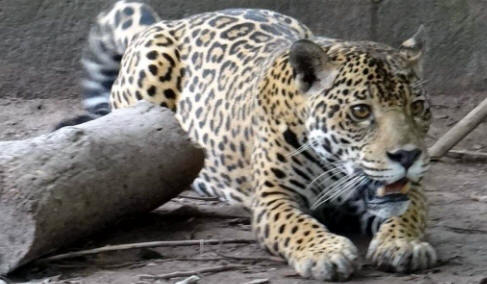
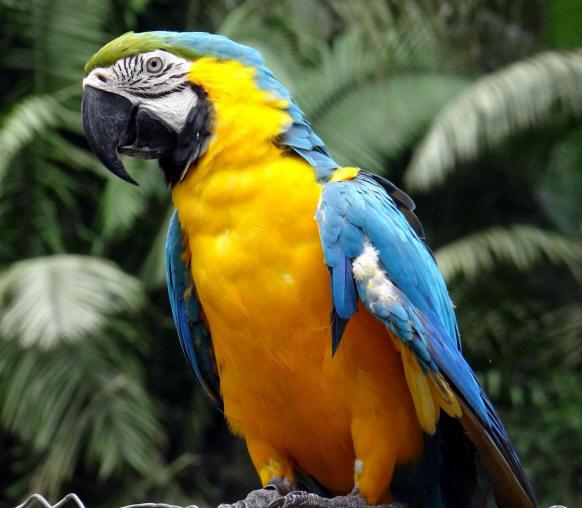
Blue macaw, a colorful bird of the Amazon Rainforest. Nearly two-thirds of Peru is Amazon rainforest, or Amazonia, which flourishes with some of the richest biodiversity on the planet.
“Only after the last tree has been cut down. Only after the last river has been poisoned. Only after the last fish has been caught. Only then will they find out that money cannot be eaten.”
(Wisdom from the Amazon jungle)
(A silent message for all of us: disconnect and reconnect with what is really important before it is too late).
Nearly two-thirds of Peru is Amazon rainforest, or Amazonia, which flourishes with some of the richest biodiversity on the planet. Covering 6,473,000 sq. km (2,500,000 sq. miles), the Amazon basin represents 56% of all remaining rainforest on the planet. This vast, largely impenetrable region, has the smallest human population in the country and few towns of any significant size. It stands in stunning contrast to the country’s rugged Andean peaks with pre Columbian Inca ruins and the arid desert coasts. The humid frontier towns of the jungle, well past stages of oil and rubber booms, now focus on ecotourism. This is a region world’s removed from the historic cities Cusco and Arequipa and the modern madness of Lima.
Many naturalists and biologists believe that Peru’s Amazon rainforest holds the greatest diversity on the planet. It teems with a staggering roster of wildlife: 350 species of mammals, 1,800 species of fish, 300 reptiles, 1,700 birds, and more than 50,000 plants. Recent studies have shown that a region just south of Iquitos has the highest concentration of mammals anywhere in the world.
A trip down the Madre de Dios or Tambopata Rivers from Puerto Maldonado immerses you in world of exotic sounds and sights, as only Mother Nature can provide. This is one of South America’s best remaining places to see the Amazon basin. Home to primary and secondary tropical forests it is alive with mammals and over 1,000 species of birds alone in it’s unspoiled forest. As the wide rivers slim down it is more interesting for viewing wildlife on the thick green banks. Out here it is necessary to go by boat and stay at a jungle lodge. We chose small local Yakari Lodge and it was a non stop adventure for 5 days as we explored what the jungle offered. Pushing our envelope continually we climbed 200 ft towers to zip line from tree to tree through the canopy above. I love zip lines. Always wanting to fly like a bird, the view is great as you zip along enjoying the canopy and monkeys with a birds eye view. There is a false sense of security and it wasn’t until I had to walk 50 feet along a 6 inch wide swinging board 200 feet up (20 stories) between the 2nd and 3rd zip line trees; that I realized just how precious life is. A tiny rope on each side, this flimsy ‘bridge’ took all my courage and focus to cross. One step at a time. Breathe. Focus. Connect. I then understood why the previous participants had all left hooting down the first zip line and returned eyes wide and faces pale. Sometimes it is better to not know what’s ahead. The canopy bridges and tree platforms seemed mighty tame after that.
Toning things down we floated down the river at night spotting large Caimans or alligators just hoping to nibble on your toes, red eyes glaring demonically in the lights. The following day we took a hike through the jungle and then swam and kayaked in the river, making sure we ‘huli’d’ or tipped over to cool off. Later we took a canoe up a small tributary to fish for piranhas. Swimming, kayaking then fishing in a small canoe in a river full of caimans, piranhas, and other unimaginable parasites and creatures was one of those times when what you don’t know won’t hurt you. Taking MMS daily (see MMS) helps with parasites, but clinical studies have not shown its effectiveness against piranhas!
A long hike down a muddy trail for hours in the jungle found us back in a remote area, far from our already isolated camp. Taking a long wooden boat we spent several hours paddling around hidden Lake Sandoval. We were not alone. Only room for 5 in the canoe we were suddenly overtaken by literally hundreds of bodies. Noticing turtles with butterflies on their heads we laughed but we soon found ourselves the new targets. Seems before mating season these butterflies are looking for salt and in the hot weather we were great salt licks. What an amusing experience to have over 100 butterflies on you at a time. Frolicking amongst the eyeballs of submerged caimans were giant otters, endless water birds. bats and monkeys, eagles and toucans.
To see wildlife up close we took the boat a further 2 hours downstream to visit a wildlife and rehabilitation center. As is the case with all wild tracks of land, very few animals hang around where humans can easily see them. They step back and watch the human intruders from a distance, or more likely they stay far back in the jungle. These animals had been captured or injured and eventually they end up back in the jungle.
On our last afternoon we went an hour downriver to visit the Iseja tribe. The Jefe, Maja, was very entertaining. He and his 8 children demonstrated how they live totally off the land, pound clothes from yanchama bark, light fires by spinning a bamboo stick in tinder, and only drink fermented fruit ‘hooch’ during special ceremonies, not like “the drunks in town up the river.” Years back missionaries arrived on the river and tried to convert his family. They brought free clothes which made them sick when they put them on, from the chemicals. They ended up throwing all the missionary gifts in the river and continued on with their worship of Nature around them.
Night walks hurled us into a whole different world. Tarantulas crawl out from their paper thin nests, colorful frogs chirp on tree branches, small mammals scurry around, and snakes slither by. The last morning we left before sunrise to travel 1 hour up the river to tie up next to a ‘clay lick’. As the sun rose in the sky an uproar started in the far off jungle. A cloud of squawking parrots and macaws descended and began their morning social activity of taking clay to balance out the minerals in their bodies. Nature Knows! What a rare experience to see this flurry of color. Poof! An hour later it was all a dream. If fact when we returned to civilization our time in the jungle seemed like a dream.
Logging and gold mining are encroaching as we speak. Gold miners shoot the monkeys for food and loggers destroy habitat. An effort for preservation is, as always, hoping for slow devastation rather than out right pillaging and raping of Mother Earth. The only saving grace is that money, big bucks, from ecotourism depends on a thriving jungle. Who will win out?
Not wanting to face the freezing temperatures of the Andes once again or days on the bus, we did what we don’t usually do – we flew to Lima. Great move. Landing in this massive city was a shock to the system and after a couple of days we moved north. The ocean side desert, with high dunes, went on for hundreds of miles. Shacks without water, people tending to hundreds of thousands of chickens in farms under tarps, was all that broke the stark landscape. Over half of Peruvians live below the poverty level and unemployment is rampant. Still the entrepreneurial spirit is strong with creative people putting together street carts to sell everything imaginable from toothpaste to French fries to vegetables to high heels.
We enjoyed staying near the expansive town square in Trujillo and were lucky enough to experience a large religious ceremony celebrating Santa Cristo. Thousands filled the usually empty square as an enormous religious ‘float’ with flowers surrounding the churches’ golden symbol burst through the door and proceeded around the square, wiping out the religious paintings or mandalas made of colored sawdust, that groups had spent all day creating for it’s path. Frenzy at the least.
Pizarro founded Trujillo in 1534, leaving behind an impressive town square and colonial buildings. Staying near the ornate, arched cultural palace had its benefits. We took in a traditional dance extravaganza, a ballet of Don Quijote, and afternoon music in the courtyard. We visited the nearby ancient metropolis of Chan Chan, miles of walls and structures paying tribute to this once powerful civilization. Containing over 10,000 structures and covering miles this pre -Columbian Chimu empire must have been impressive in it’s heyday, as it still is. The Moche temples or pyramids, made of adobe like Chan Chan are, 700 years older. The Huaca del Sol is the largest structure, requiring 140 million bricks to construct. Hanging around these ruins are the bizarre looking Peruvian hairless dogs. Their body temperature is higher than that of regular dogs or ‘perros’ so they are used by people with arthritis to keep their aching joints warm!
We spent several days hanging with surfers from around the world in nearby Huanchaco. ‘Chillin’ on the beach, watching waves and fishermen in their cigar shaped totoro boats called ‘caballitos’ (little horses) riding the waves next to surfers, was our main activity.
Arriving in Paita I asked the woman next to me on the bus, “Where should we go next?” She pointed to a unknown peninsula on the map. I asked Joseph to pick out one of the fishing villages. Randomly he picked out Yacila or “the Y town”. His intuition was right, as it usually is and we spent the next 10 days in one of the remotest and most picturesque fishing villages in Northern Peru. Based around a fleet of fishing boats hauling in giant squid, this sleepy village was so small that there were only stores in the back of locals houses and a couple of cafes along the beach. I made friends with Corina and she would pick up fresh vegetables and fruit in the next village 3 times a week. We made a deal with Victor and stayed in a comfortable, modern home with breathtaking views of the bay and ocean beyond. We took walks along the high mountain ridge behind the house daily and dropped down onto the beach behind. We got to know just about everyone in the tiny village and were sad to move on, having already extended our stay a second time. This is one of the benefits of traveling slowly. Four days at the final beach town in Peru, Mancora, completed our up close look at the expansive northern coast. From Lake Titicaca, to Machu Pichu high in the Andes, to the steamy jungles of the Amazon basin, to the rugged deserts of the northern coast, the diverse country of Peru has so many gifts to offer the traveler willing to receive them.
For a fun graph pointing out 50 astounding facts about “Why the Amazon Rainforest Rules” click here:
http://www.huffingtonpost.com/2013/09/12/rainforest-facts_n_3914973.html?utm_hp_ref=tw
And so it goes…………………………………..Next exploring the small but diverse country of Ecuador further north. Until next month Keep Smiling and remember to live lightly on the earth. Mother Earth needs everyone’s help now more than ever. We are glad you stopped by. Thanks for keeping in touch! Take care!
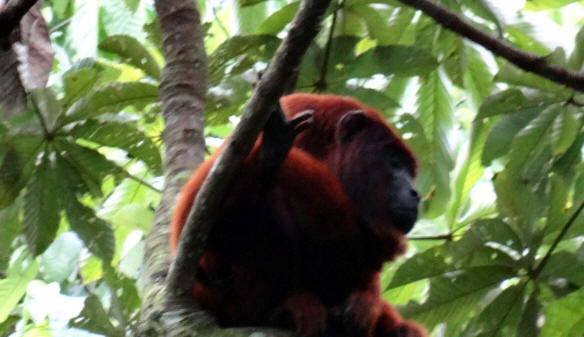
Monkeys, curious fellows, love to follow you as you hike
through the jungle.
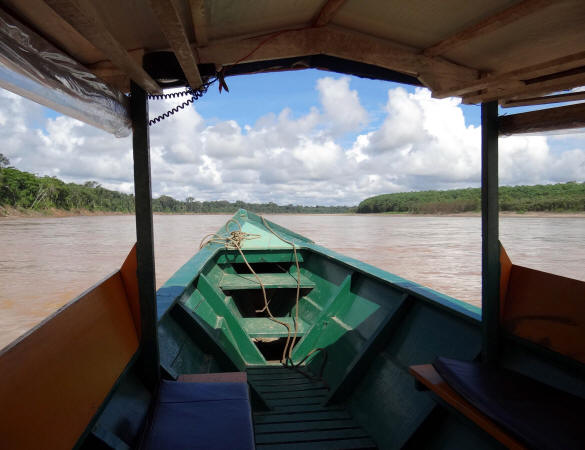
A trip down the Madre de Dios or Tambopata Rivers from Puerto
Maldonado immerses you in world of exotic sounds and sights,
as only Mother Nature can provide.

Beautiful blue eyes rivaling Frank Sinatra any day!.
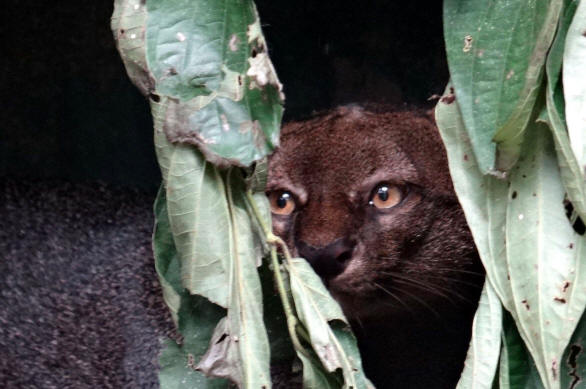
Stealth.
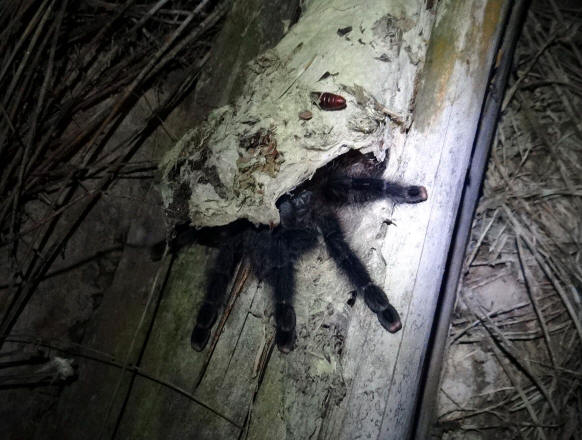
Pink footed tarantula hiding on the tree next to our cabin.

Spiders as big as dogs!

A swinging bridge high up in the canopy. Great place to
observe birds and monkeys in their natural habitat.

The tower to climb up to the canopy of the rain forest,
over 10 storey’s above.

Look carefully, either a monkey or Nancy
flying along on a zip line.
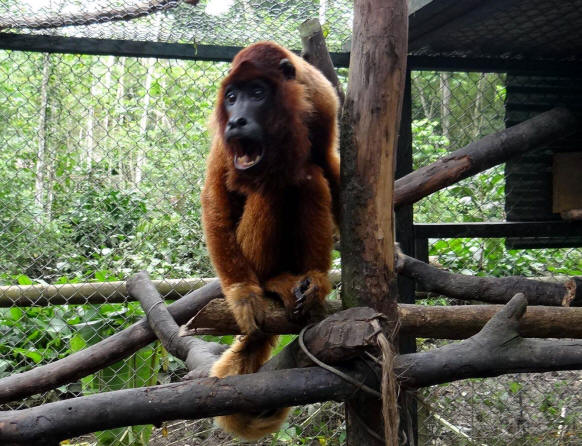
When you trek through the Amazon jungle you are immersed in
sounds, sights,smells like no where else. Quote from a volunteer:
When electricity is scarce, water
is not drinkable, the weather is not always in your favor, mosquitoes,
and many other insects bother you 24h a day, and phone reception is
poor, we realize how dependent of technology and comfort we are.”
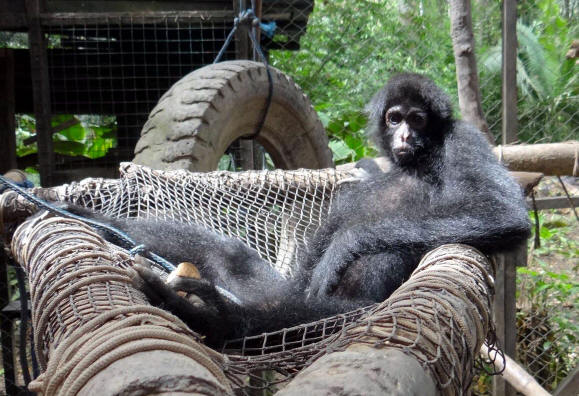
Getting a photo of a moving animal, high in the canopy 60 feet
above, is lucky and rare. Usually just looks like a little black
spot in a tree.
Love, Light & Laughter,
xoxoox Nancy & Joseph
Travel notes:
Puerto Maldonado:
Hostal Sol de Tambopata: phone # 503099 worth the extra little walk to have a quiet, modern room
Yakari Lodge: 51 082 502207 [email protected]
This well run lodge is comfortable, clean and right in the jungle. Great food provided by an experienced cook from Lima who does good vegetarian meals.
Lima:
Pay a little more and stay in the Miraflores area. Do NOT stay in the center of town, as is the case in many colonial towns. Too shady – knowing us and our lack of living in fear as we travel – please take note.
Trujillo:
Hotel Colonial, phone # 044 258261, large old hotel with character, near the plaza. Choose a room that is quiet.font-size:large;
Eat at Le Nature, for lunch, great inexpensive food, phone # 44-209674, Marcelo corne 338 Urb San Andres. About 6 blocks down from the Central Plaza.
Huanchaco:
Hostal McCallum, phone #044 626923. Clean, modern, hot water, kitchen. Get a room upstairs in the corner. (#303)
Yacila:
Call Victor at # 99 628 9473. This is a place we would return to. One of a kind remote, beautiful village. Great modern apartment to rent by the week with a full view of the beautiful bay below!
Paita:
Veggie restaurant on the park by the Post Office – Matheos
Mancora:
Sol de Mancora: (073) 496883 -right near the beach – modern, clean little rooms in a pleasant courtyard.
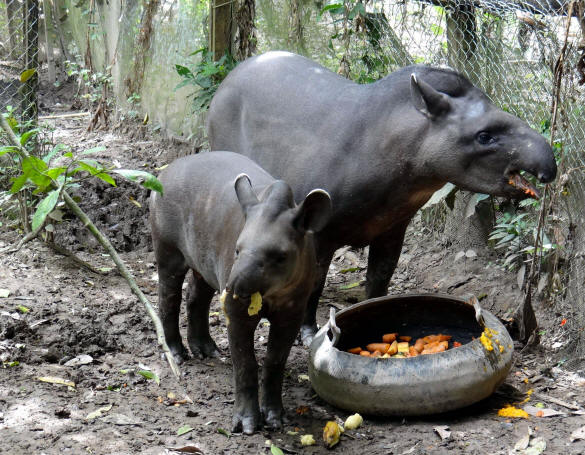
Curious looking jungle tapirs. We took the canoe 2 hours down river
to visit http://www.amazonshelter.org. /
There we had an up close look at the injured animals recovering
before being released back into the wild.

The Jefe, Maja, of the Iseja tribe.
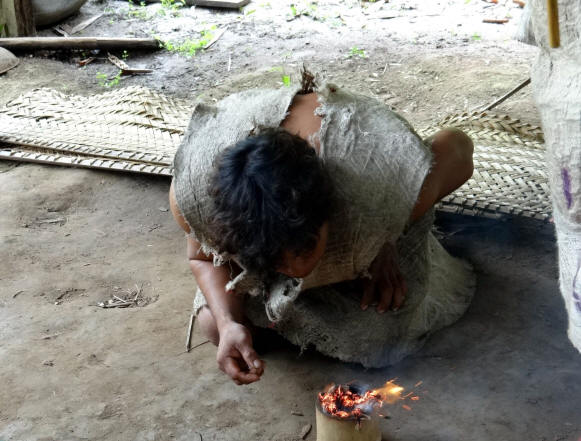
He and his 8 children demonstrated how they live totally off the land,
pound clothes from yanchama bark, light fires by spinning a bamboo
stick in tinder, and only drink fermented fruit ‘hooch’ during special ceremonies, not like “the drunks in town up the river.”
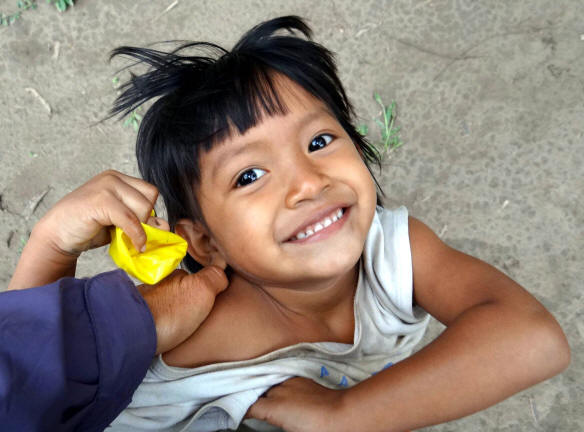
The family ended up throwing all the clothing and gifts from the
missionaries into the river, and continued with their worship
of Nature around them. I guess my balloon was allowed.
In fact fun and playing are always part of remote tribes!

Colorful heleconias brighten the thick green jungle.

Yellow beauties high in the canopy.

At first glance the river and lakes look safe and quiet.

We went for a kayak ride down river, then an inevitable
swim when it flipped.

Later we went piranha fishing down a small, quiet tributary
nearby. What you don’t know won’t hurt you. Taking M*MS
daily (see M*MS) helps with parasites, but clinical studies have
not shown its effectiveness against piranhas!
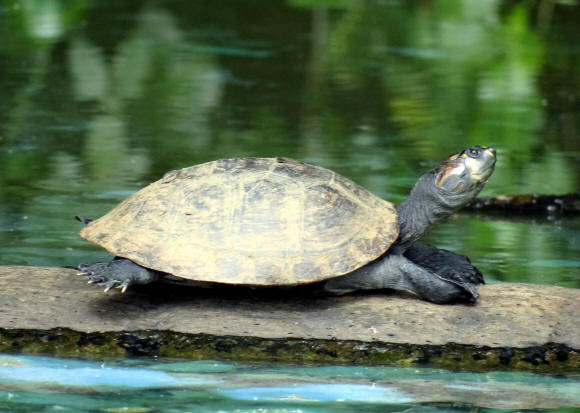
Turtles sunning on every log. We laughed as each one had a butterfly or two on their head.

We hiked hours through the jungle to get to Lake Sandoval. We were
not alone. We soon found ourselves the new targets for the butterflies.
Seems before mating season these butterflies are looking for salt and in
the hot weather we were great salt licks. What an amusing
experience to have over 100 butterflies on you at a time.

‘Mariposas’ or butterflies of every color.
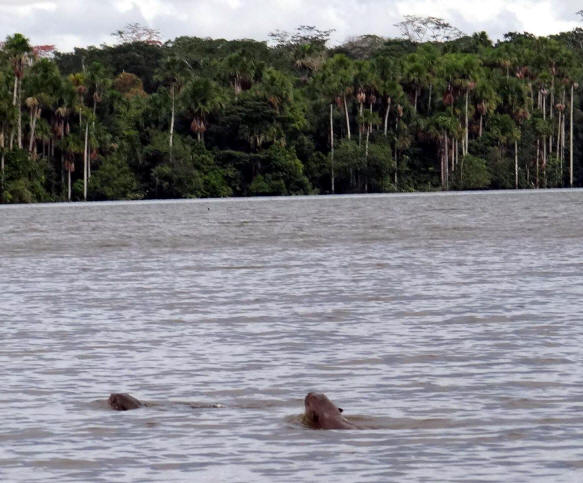
Frolicking giant river otters. They know how to have fun!

These large birds had a shrill squawk and announced your arrival
to everyone around.

The sun rises at 5am on the river. It would take something special
to roust me out at 3:45 to go upriver 1 hour.
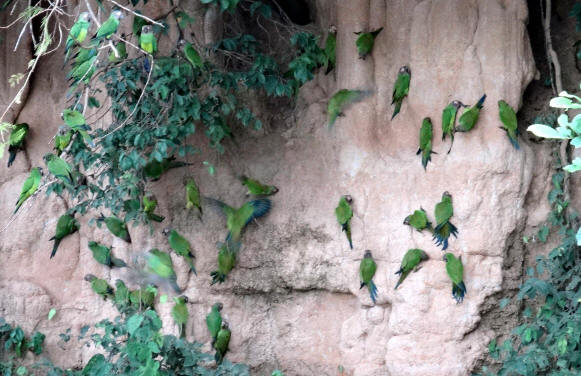
We were not disappointed. As the sun rose in the sky an uproar
started in the far off jungle. A cloud of squawking parrots and
macaws descended and began their morning social activity of
taking clay to balance out the minerals in their bodies.
Nature Knows!

What a rare experience to see this flurry of color. Poof!
An hour later it was all a dream.

If fact when we returned to civilization our time in the jungle
seemed like a dream.
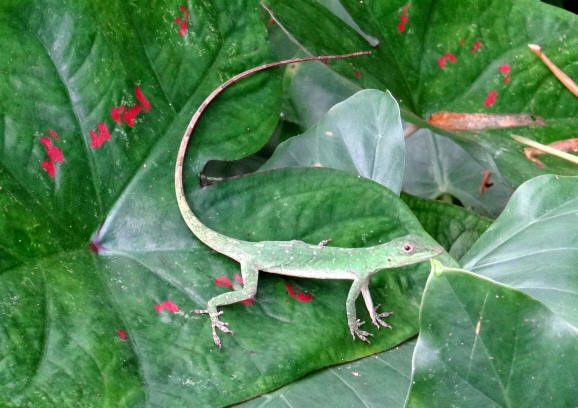
Camouflage is the name of the survival game here.

Back in Puerto Maldonado we happened on a
noisy, bright troupe of men in the market while
shopping for fruit. Some kind of religious
celebration. Interesting.

Not wanting to face the freezing temperatures of the Andes once again
or days on the bus, we did what we don’t usually do – we flew to Lima.
Great move.

Endless ‘barios’ of the capitol city of Lima. A shock to the system.
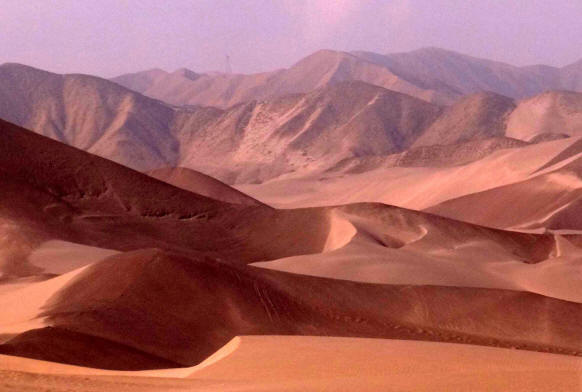
The ocean side desert, with high dunes, went on for hundreds of
miles north of Lima.
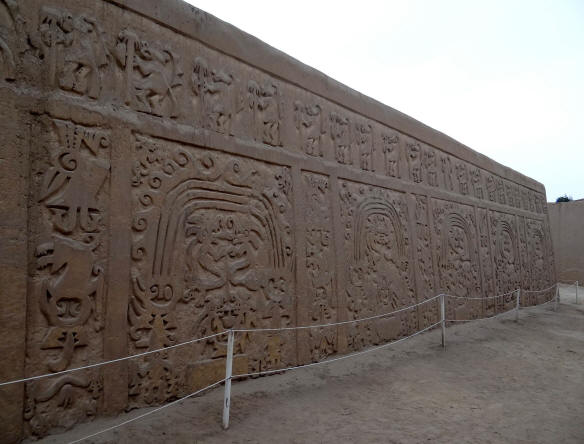
We visited the nearby ancient metropolis of Chan Chan, miles of walls
and structures paying tribute to this once powerful civilization.
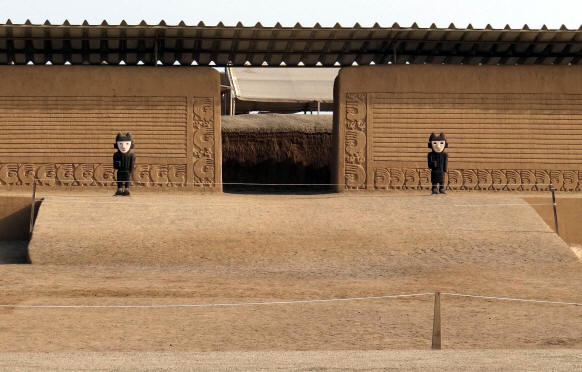
Containing over 10,000 structures and covering miles, this pre -Columbian Chimu empire must have been impressive in it’s heyday, as it still is.

The sun sets off Huanchaco shining on their unique reed fishing boats.
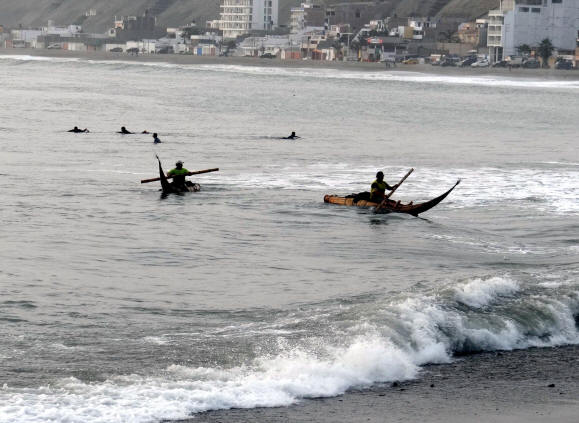
Fishermen in their cigar shaped totoro boats called ‘caballitos’
(little horses) riding the waves next to surfers.

This storyteller had the crowd roaring.

We happened on a local dance extravaganza.
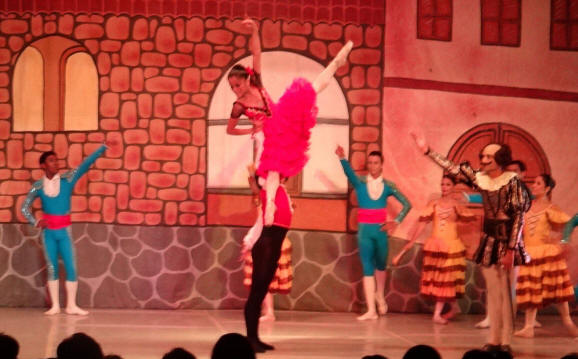
Trujillo was full of cultural events. This ballet was a treat to see.
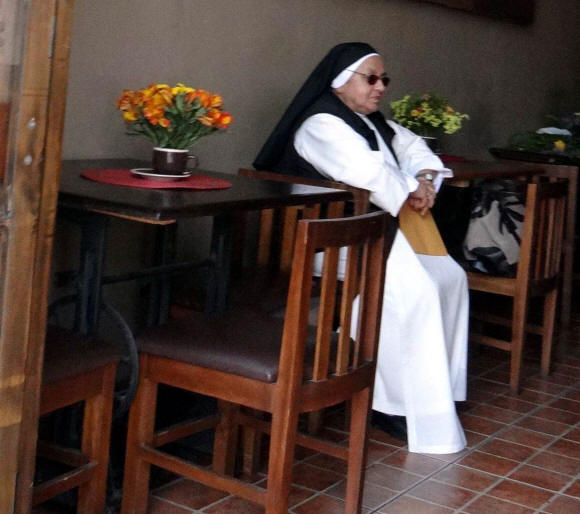
The crowning event was the Catholic religious celebration of
Santa Cristo.

A jester gave out balloons to the excited crowd of thousands.

Women now hold a more prominent role in the Catholic Church masses and celebrations. These lovely young dancers were a hit.
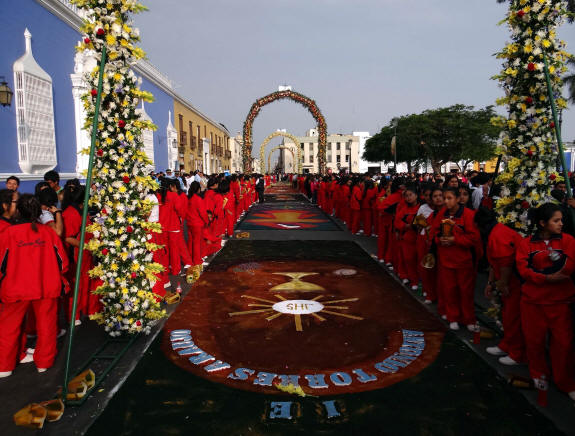
Thousands filled the usually empty square as an enormous religious’float’ with flowers surrounding the churches’ golden symbol burst

High surf in Yacila.

Based around a fleet of fishing boats hauling in giant squid, this sleepy
village was so remote that there were only stores in the back of local
houses and a couple of cafes along the beach.

A large sea lion cruises the bay.

The original paddle board!
The usual mode of transport out to the fishing boats.

Tucked in the cove for the night. Our view from
the front porch.
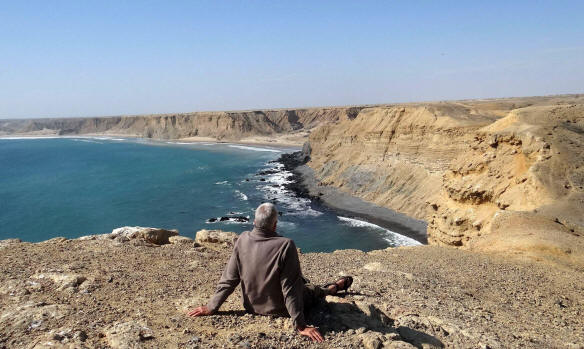
Every day we hiked up to the ridge and along the edge. The
view was stunning. We could definitely return here for a
month or so.
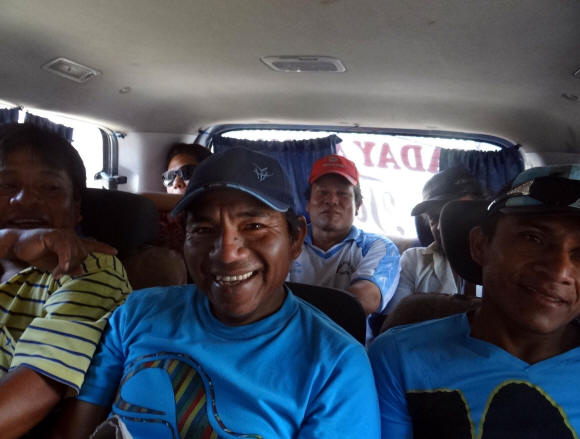
Happy ‘compadres’ on our little bus heading north.

